NASA is quite proud of its spinoffs technology developed for the space agency’s needs in space that in turn contribute to commercial innovations that improve life here on Earth. And rightly so. Just as a quick example, improvements in spacesuits have led to better protection for firefighters, scuba divers and people working in cold weather. But the list of NASA spinoffs is quite extensive.
Just like NASA, the European Space Agency (ESA) has a Technology Transfer office to help inventors and businesses use space technology for non-space applications. The latest invention touted as an ESA spinoff is a small hand-held device called a Carbon Hero that might help make people more aware of the carbon footprint they are leaving behind due to vehicle emissions.
Used in conjunction with a cell phone, the Carbon Hero receives data from navigation satellites to determine the mode of transportation being used. The device’s algorithm is able to use the speed and position of the user to determine how they are traveling, and how much CO2 they are generating. The user doesn’t have to enter any information, the data is computed automatically.
The user would get feedback on the environmental impact of different types of transportation – whether by train, plane, bike or by foot. The Carbon Hero lets the user compare one kind of travel with another and calculate the environmental benefits daily, weekly and monthly.
“If you go on a diet you want to see if all that effort has made a difference so you weigh yourself. The beauty of our system is that it’s easy; you have a “weighing scale” on you all the time giving you your carbon footprint. When you make the effort to walk instead of taking the car you can immediately see the result, so it feels more worthwhile doing it and you are more likely to stick with it,” says Andreas Zachariah, a graduate student from the Royal College of Art in London and inventor of Carbon Hero.
The device has been tested using the GPS system, but will be fully operational after Galileo, the European global navigation system is fully up and running.
Learn more about ESA’s Technology Transfer Programme Office.
Learn more about NASA Spinoffs.
Original News Source: ESA Press Release





